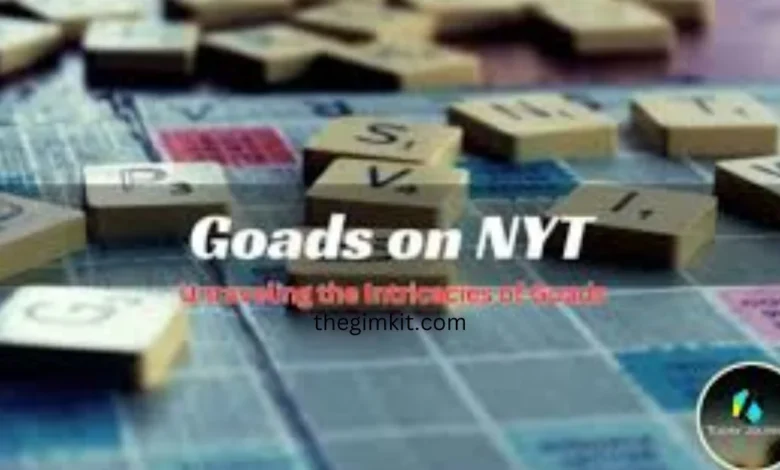A Deep Dive into Goads on NYT

Introduction to Goads on NYT
Welcome to the thrilling global of Goads on NYT! Dive deep into the history, controversies, and destiny possibilities surrounding those exciting features. Join us as we find out how Goads have revolutionized the way we devour information and interact with content material on The New York Times. Strap in for an interesting journey through the evolution and effect of Goads on NYT in a contemporary ever-changing media panorama.
The History and Evolution of Goads on NYT
The History and Evolution of Goads on NYT dates back to the early days of print journalism. As the New York Times embraced digital platforms, goads became a key element in taking pictures of readers’ interest. Initially used as clickable factors to pressure visitors within articles, goads advanced into interactive tools imparting extra context or multimedia content.
Over time, the NYT refined its method to integrate goads seamlessly into its online articles, improving consumer enjoyment and engagement. With technological advancements, goads have ended up extra sophisticated, adapting to changing reader possibilities and behaviors.
Goads on NYT have performed a critical function in monetization techniques with the aid of developing opportunities for subsidized content material or native advertising. While a few critics argue that excessive use of goads may additionally distract from the principle content material, others respect their ability to provide precious supplementary records.
In the latest virtual panorama, the evolution of goads keeps as newspapers are trying to find revolutionary approaches to captivate audiences and power sales streams efficiently.
The Impact of Goads on NYT in Today’s Society
Goads on NYT have revolutionized how news is fed on in the latest society. These interactive activities embedded within articles compel readers to interact similarly with the content material, encouraging a deeper know-how of the troubles at hand.
In an age where attention spans are fleeting, goads offer a gateway for users to delve into associated subjects seamlessly. This accelerated interactivity no longer best enhances consumer enjoyment but also fosters a greater knowledgeable readership.
Moreover, through imparting extra context or multimedia elements via goads, NYT can cater to numerous getting-to-know possibilities and hobbies among its target audience. This customization results in a more customized information intake experience.
The impact of goads extends beyond simply informing; they spark discussions, encourage curiosity, and pressure individuals to discover various views surrounding a tale. As society keeps evolving digitally, these diffused nudges toward deeper engagement play a vital position in shaping nicely informed communities.
Controversies Surrounding Goads on NYT

Controversies surrounding goads on NYT have sparked debates among readers and media professionals. One important concern is the ethical implications of the use of mental techniques to steer readers’ conduct. Critics argue that goads could manipulate emotions and evaluations, leading to biased information consumption.
Additionally, there are issues about the ability impact on journalistic integrity. Some worry that sensationalized headlines pushed using goads may also prioritize clicks over real reporting. This increases questions on the responsibility of media stores like NYT in retaining credibility while attracting audiences efficiently.
Moreover, there may be a debate approximately consumer privacy and statistics series through goads. Critics worry that personalized content material guidelines based totally on personal behavior ought to infringe upon people’s privacy rights. These controversies highlight the complexities surrounding the usage of goads in current journalism and get in touch with a considerate method to balance engagement with ethics.
How Other Newspapers are Using Goads to Engage Readers
Other newspapers have taken observation of the success of goads on NYT and are implementing comparable techniques to captivate their readers. By incorporating interactive elements like polls, quizzes, and countdowns within their articles, those newspapers intend to keep their target market engaged and on their toes.
Goads are not pretty much-supplying facts; they function as a tool for creating an immersive reading experience. Readers no longer passively consume news but actively take part in it through those attractive capabilities. This shift from traditional static content material to dynamic multimedia factors has revolutionized the way information is fed.
With interest spans decreasing in this virtual age, newspapers apprehend the significance of keeping readers hooked. Goads offer a refreshing smash from monotonous textual content and help maintain reader interest in the course of a piece of writing. It’s all about striking a balance between informative content and interactive engagement to cater to modern-day target audience choices.
Future Possibilities for Goads on NYT
As the era keeps improving, the destiny possibilities for goads on NYT are limitless. Imagine interactive goads that allow readers to customize their information feed based on their pursuits and choices. These tailored reviews may want to enhance consumer engagement and keep readers coming back for more.
Furthermore, with the upward push of augmented reality (AR) and virtual reality (VR), NYT could doubtlessly introduce immersive storytelling studies through goads. Picture a situation in which users can step into a breaking news story or historic occasion through AR overlays precipitated with the aid of precise goads.
Moreover, as synthetic intelligence (AI) capabilities improve, goads on NYT ought to emerge as even more intuitive and predictive. AI algorithms may want to examine reader behavior to suggest customized content seamlessly incorporated inside articles through diffused goads.
The integration of the blockchain era may additionally revolutionize how records are demonstrated and accessed via transparent statistics sourcing embedded in goads. This could now not handiest decorate credibility however additionally foster agreement amongst readers in a technology plagued with fake information controversies.
In essence, destiny holds endless opportunities for innovation in how goads on NYT can remodel the manner we consume information and interact with media systems.
Conclusion:
Goads on NYT have come a long way due to the fact their inception, evolving into powerful equipment for attractive readers and driving conversations. The history of goads on NYT showcases how they have adapted to the virtual age, continuously innovating to seize target audience attention in an ever-changing media landscape.
In modern-day society, goads on NYT play an important function in shaping public discourse and preserving readers’ knowledge. While controversies may arise surrounding their use, it is clear that goads are right here to live as an essential part of journalism.
Read More: Top 10 Fiskning Tips for Beginners




